Applied Business Finance: Financial Statements, Ratios & Improvement
VerifiedAdded on 2023/06/13
|12
|2577
|382
Report
AI Summary
This report provides a comprehensive analysis of financial management principles and their application in evaluating business performance. It begins by defining financial management and its importance, followed by a discussion of key financial statements, including the cash flow statement, income statement, and balance sheet. The report then delves into the use of financial ratios, such as profitability, liquidity, and efficiency ratios, to assess a company's financial health and compare it to competitors. An income statement and balance sheet are presented, and various financial ratios are computed with detailed interpretations. Finally, the report elaborates on the processes companies use to improve their financial performance, emphasizing the importance of cash flow management, technology adoption, and innovation. The conclusion highlights the role of financial management in achieving organizational goals and the significance of financial statements in informing investment decisions.

Applied business
Finance.
Finance.
Paraphrase This Document
Need a fresh take? Get an instant paraphrase of this document with our AI Paraphraser
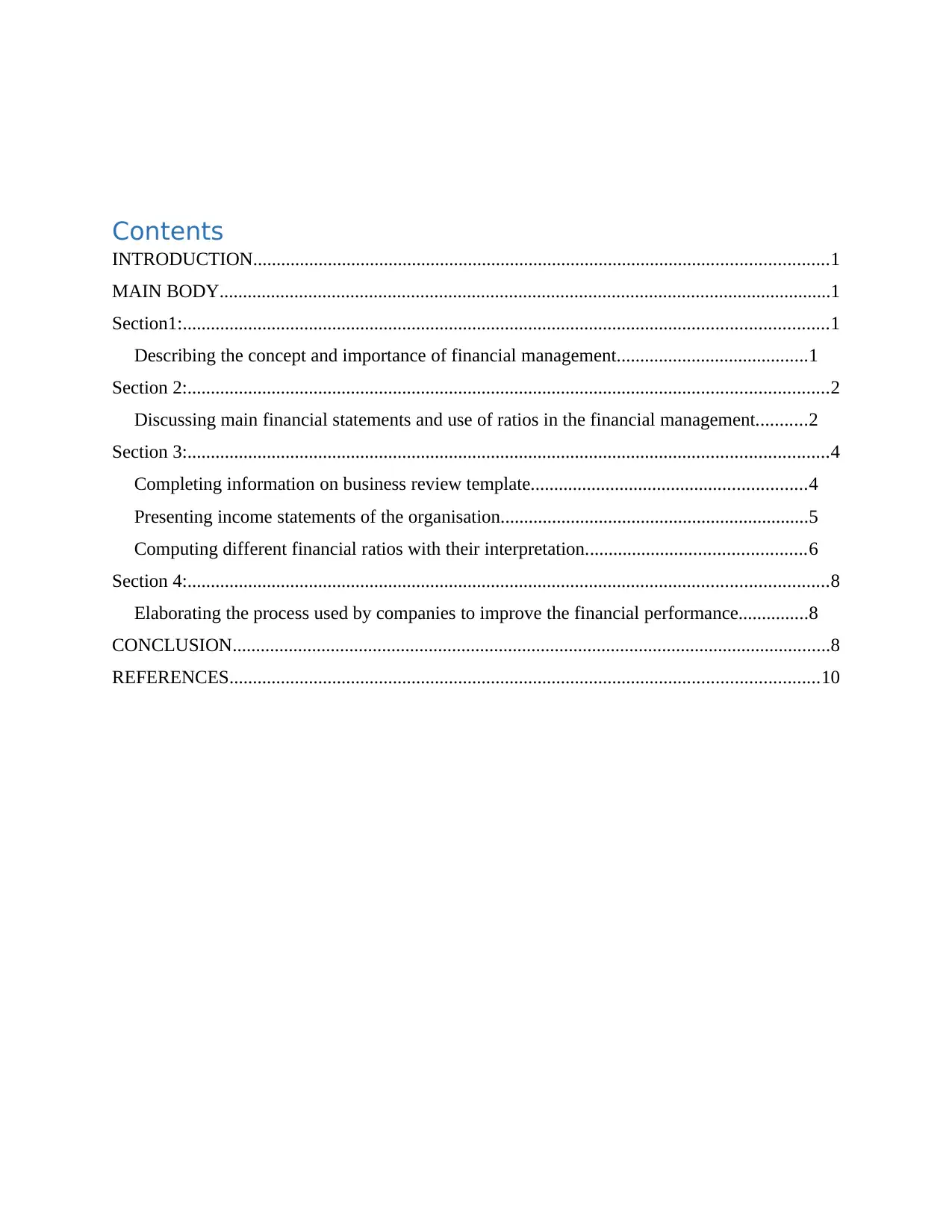
Contents
INTRODUCTION...........................................................................................................................1
MAIN BODY...................................................................................................................................1
Section1:..........................................................................................................................................1
Describing the concept and importance of financial management.........................................1
Section 2:.........................................................................................................................................2
Discussing main financial statements and use of ratios in the financial management...........2
Section 3:.........................................................................................................................................4
Completing information on business review template...........................................................4
Presenting income statements of the organisation..................................................................5
Computing different financial ratios with their interpretation...............................................6
Section 4:.........................................................................................................................................8
Elaborating the process used by companies to improve the financial performance...............8
CONCLUSION................................................................................................................................8
REFERENCES..............................................................................................................................10
INTRODUCTION...........................................................................................................................1
MAIN BODY...................................................................................................................................1
Section1:..........................................................................................................................................1
Describing the concept and importance of financial management.........................................1
Section 2:.........................................................................................................................................2
Discussing main financial statements and use of ratios in the financial management...........2
Section 3:.........................................................................................................................................4
Completing information on business review template...........................................................4
Presenting income statements of the organisation..................................................................5
Computing different financial ratios with their interpretation...............................................6
Section 4:.........................................................................................................................................8
Elaborating the process used by companies to improve the financial performance...............8
CONCLUSION................................................................................................................................8
REFERENCES..............................................................................................................................10
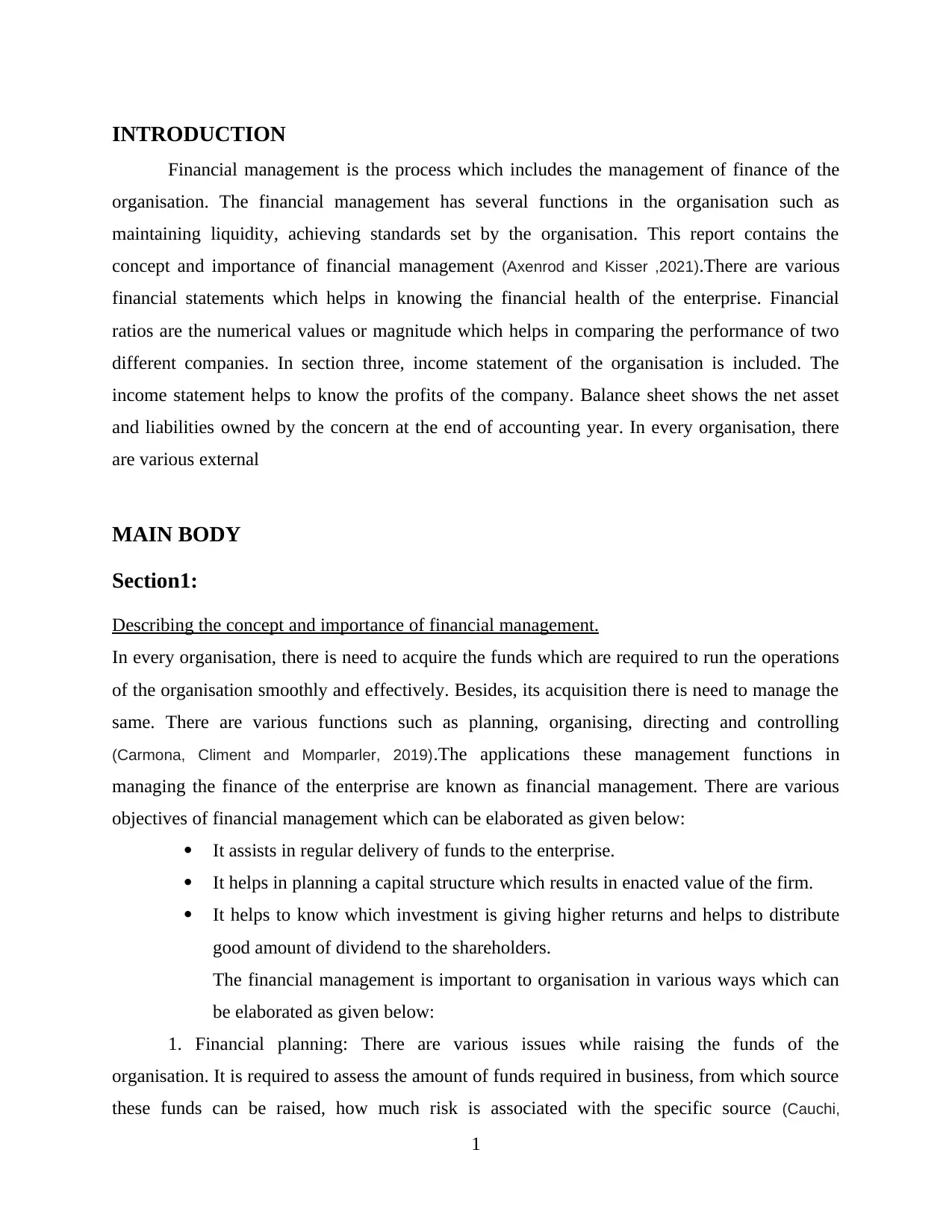
INTRODUCTION
Financial management is the process which includes the management of finance of the
organisation. The financial management has several functions in the organisation such as
maintaining liquidity, achieving standards set by the organisation. This report contains the
concept and importance of financial management (Axenrod and Kisser ,2021).There are various
financial statements which helps in knowing the financial health of the enterprise. Financial
ratios are the numerical values or magnitude which helps in comparing the performance of two
different companies. In section three, income statement of the organisation is included. The
income statement helps to know the profits of the company. Balance sheet shows the net asset
and liabilities owned by the concern at the end of accounting year. In every organisation, there
are various external
MAIN BODY
Section1:
Describing the concept and importance of financial management.
In every organisation, there is need to acquire the funds which are required to run the operations
of the organisation smoothly and effectively. Besides, its acquisition there is need to manage the
same. There are various functions such as planning, organising, directing and controlling
(Carmona, Climent and Momparler, 2019).The applications these management functions in
managing the finance of the enterprise are known as financial management. There are various
objectives of financial management which can be elaborated as given below:
It assists in regular delivery of funds to the enterprise.
It helps in planning a capital structure which results in enacted value of the firm.
It helps to know which investment is giving higher returns and helps to distribute
good amount of dividend to the shareholders.
The financial management is important to organisation in various ways which can
be elaborated as given below:
1. Financial planning: There are various issues while raising the funds of the
organisation. It is required to assess the amount of funds required in business, from which source
these funds can be raised, how much risk is associated with the specific source (Cauchi,
1
Financial management is the process which includes the management of finance of the
organisation. The financial management has several functions in the organisation such as
maintaining liquidity, achieving standards set by the organisation. This report contains the
concept and importance of financial management (Axenrod and Kisser ,2021).There are various
financial statements which helps in knowing the financial health of the enterprise. Financial
ratios are the numerical values or magnitude which helps in comparing the performance of two
different companies. In section three, income statement of the organisation is included. The
income statement helps to know the profits of the company. Balance sheet shows the net asset
and liabilities owned by the concern at the end of accounting year. In every organisation, there
are various external
MAIN BODY
Section1:
Describing the concept and importance of financial management.
In every organisation, there is need to acquire the funds which are required to run the operations
of the organisation smoothly and effectively. Besides, its acquisition there is need to manage the
same. There are various functions such as planning, organising, directing and controlling
(Carmona, Climent and Momparler, 2019).The applications these management functions in
managing the finance of the enterprise are known as financial management. There are various
objectives of financial management which can be elaborated as given below:
It assists in regular delivery of funds to the enterprise.
It helps in planning a capital structure which results in enacted value of the firm.
It helps to know which investment is giving higher returns and helps to distribute
good amount of dividend to the shareholders.
The financial management is important to organisation in various ways which can
be elaborated as given below:
1. Financial planning: There are various issues while raising the funds of the
organisation. It is required to assess the amount of funds required in business, from which source
these funds can be raised, how much risk is associated with the specific source (Cauchi,
1
⊘ This is a preview!⊘
Do you want full access?
Subscribe today to unlock all pages.

Trusted by 1+ million students worldwide
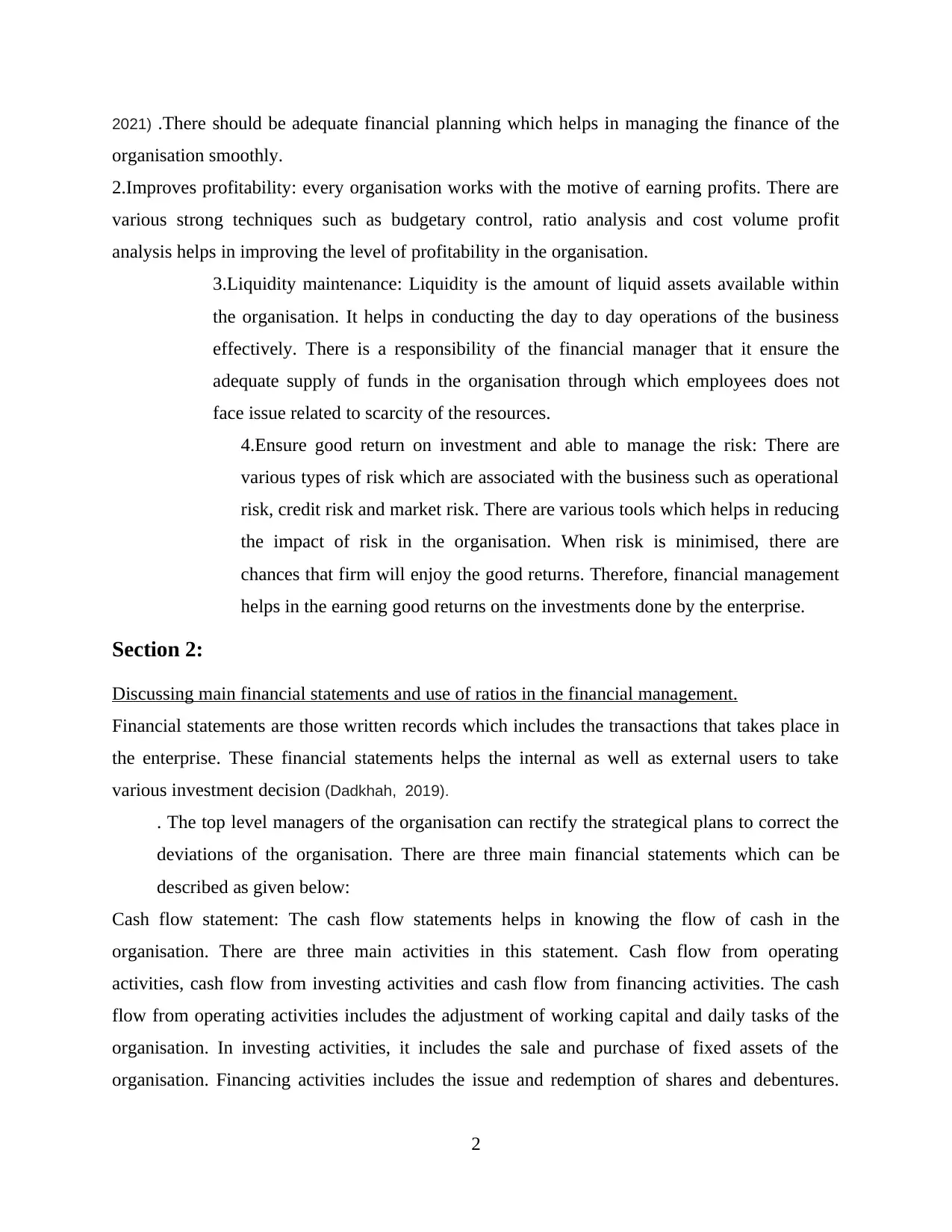
2021) .There should be adequate financial planning which helps in managing the finance of the
organisation smoothly.
2.Improves profitability: every organisation works with the motive of earning profits. There are
various strong techniques such as budgetary control, ratio analysis and cost volume profit
analysis helps in improving the level of profitability in the organisation.
3.Liquidity maintenance: Liquidity is the amount of liquid assets available within
the organisation. It helps in conducting the day to day operations of the business
effectively. There is a responsibility of the financial manager that it ensure the
adequate supply of funds in the organisation through which employees does not
face issue related to scarcity of the resources.
4.Ensure good return on investment and able to manage the risk: There are
various types of risk which are associated with the business such as operational
risk, credit risk and market risk. There are various tools which helps in reducing
the impact of risk in the organisation. When risk is minimised, there are
chances that firm will enjoy the good returns. Therefore, financial management
helps in the earning good returns on the investments done by the enterprise.
Section 2:
Discussing main financial statements and use of ratios in the financial management.
Financial statements are those written records which includes the transactions that takes place in
the enterprise. These financial statements helps the internal as well as external users to take
various investment decision (Dadkhah, 2019).
. The top level managers of the organisation can rectify the strategical plans to correct the
deviations of the organisation. There are three main financial statements which can be
described as given below:
Cash flow statement: The cash flow statements helps in knowing the flow of cash in the
organisation. There are three main activities in this statement. Cash flow from operating
activities, cash flow from investing activities and cash flow from financing activities. The cash
flow from operating activities includes the adjustment of working capital and daily tasks of the
organisation. In investing activities, it includes the sale and purchase of fixed assets of the
organisation. Financing activities includes the issue and redemption of shares and debentures.
2
organisation smoothly.
2.Improves profitability: every organisation works with the motive of earning profits. There are
various strong techniques such as budgetary control, ratio analysis and cost volume profit
analysis helps in improving the level of profitability in the organisation.
3.Liquidity maintenance: Liquidity is the amount of liquid assets available within
the organisation. It helps in conducting the day to day operations of the business
effectively. There is a responsibility of the financial manager that it ensure the
adequate supply of funds in the organisation through which employees does not
face issue related to scarcity of the resources.
4.Ensure good return on investment and able to manage the risk: There are
various types of risk which are associated with the business such as operational
risk, credit risk and market risk. There are various tools which helps in reducing
the impact of risk in the organisation. When risk is minimised, there are
chances that firm will enjoy the good returns. Therefore, financial management
helps in the earning good returns on the investments done by the enterprise.
Section 2:
Discussing main financial statements and use of ratios in the financial management.
Financial statements are those written records which includes the transactions that takes place in
the enterprise. These financial statements helps the internal as well as external users to take
various investment decision (Dadkhah, 2019).
. The top level managers of the organisation can rectify the strategical plans to correct the
deviations of the organisation. There are three main financial statements which can be
described as given below:
Cash flow statement: The cash flow statements helps in knowing the flow of cash in the
organisation. There are three main activities in this statement. Cash flow from operating
activities, cash flow from investing activities and cash flow from financing activities. The cash
flow from operating activities includes the adjustment of working capital and daily tasks of the
organisation. In investing activities, it includes the sale and purchase of fixed assets of the
organisation. Financing activities includes the issue and redemption of shares and debentures.
2
Paraphrase This Document
Need a fresh take? Get an instant paraphrase of this document with our AI Paraphraser
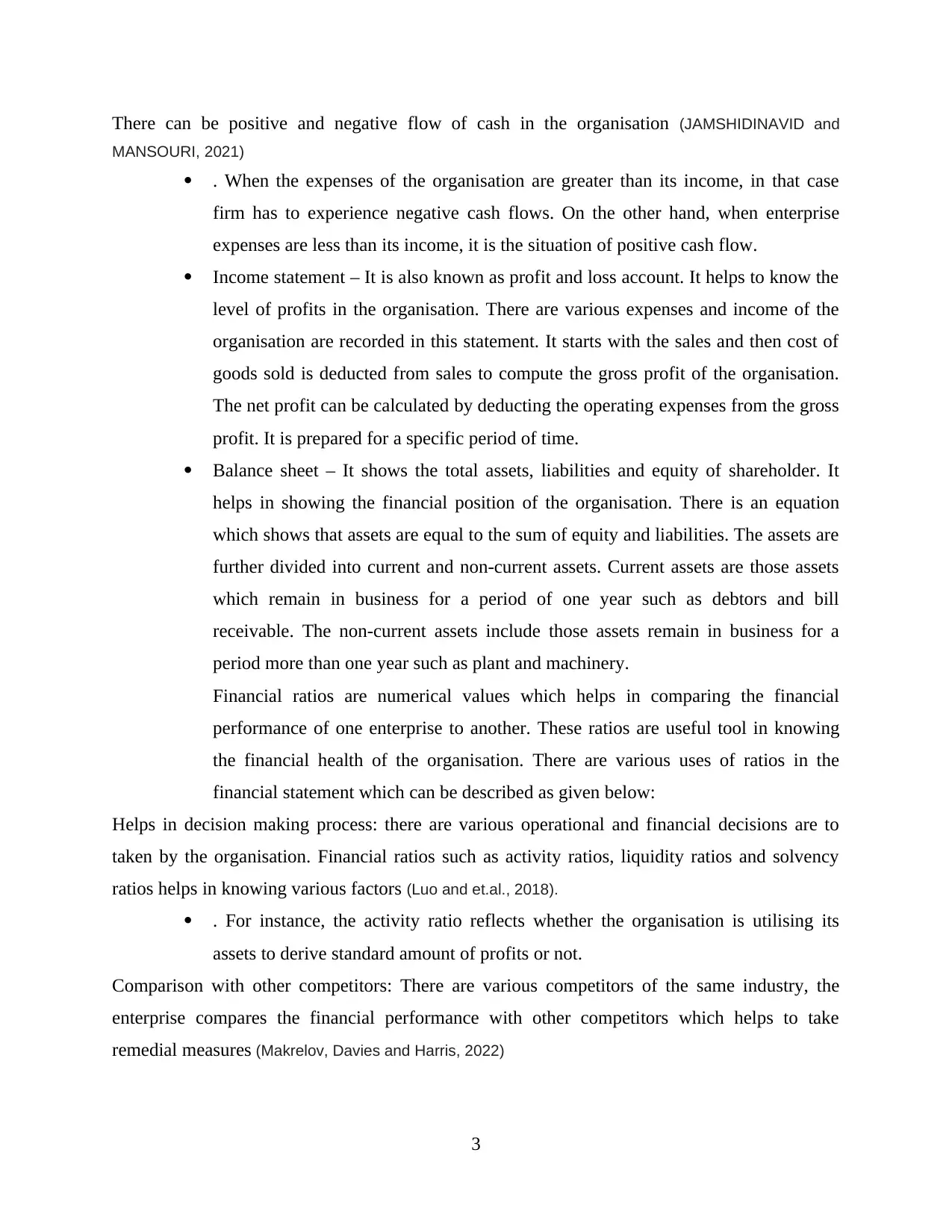
There can be positive and negative flow of cash in the organisation (JAMSHIDINAVID and
MANSOURI, 2021)
. When the expenses of the organisation are greater than its income, in that case
firm has to experience negative cash flows. On the other hand, when enterprise
expenses are less than its income, it is the situation of positive cash flow.
Income statement – It is also known as profit and loss account. It helps to know the
level of profits in the organisation. There are various expenses and income of the
organisation are recorded in this statement. It starts with the sales and then cost of
goods sold is deducted from sales to compute the gross profit of the organisation.
The net profit can be calculated by deducting the operating expenses from the gross
profit. It is prepared for a specific period of time.
Balance sheet – It shows the total assets, liabilities and equity of shareholder. It
helps in showing the financial position of the organisation. There is an equation
which shows that assets are equal to the sum of equity and liabilities. The assets are
further divided into current and non-current assets. Current assets are those assets
which remain in business for a period of one year such as debtors and bill
receivable. The non-current assets include those assets remain in business for a
period more than one year such as plant and machinery.
Financial ratios are numerical values which helps in comparing the financial
performance of one enterprise to another. These ratios are useful tool in knowing
the financial health of the organisation. There are various uses of ratios in the
financial statement which can be described as given below:
Helps in decision making process: there are various operational and financial decisions are to
taken by the organisation. Financial ratios such as activity ratios, liquidity ratios and solvency
ratios helps in knowing various factors (Luo and et.al., 2018).
. For instance, the activity ratio reflects whether the organisation is utilising its
assets to derive standard amount of profits or not.
Comparison with other competitors: There are various competitors of the same industry, the
enterprise compares the financial performance with other competitors which helps to take
remedial measures (Makrelov, Davies and Harris, 2022)
3
MANSOURI, 2021)
. When the expenses of the organisation are greater than its income, in that case
firm has to experience negative cash flows. On the other hand, when enterprise
expenses are less than its income, it is the situation of positive cash flow.
Income statement – It is also known as profit and loss account. It helps to know the
level of profits in the organisation. There are various expenses and income of the
organisation are recorded in this statement. It starts with the sales and then cost of
goods sold is deducted from sales to compute the gross profit of the organisation.
The net profit can be calculated by deducting the operating expenses from the gross
profit. It is prepared for a specific period of time.
Balance sheet – It shows the total assets, liabilities and equity of shareholder. It
helps in showing the financial position of the organisation. There is an equation
which shows that assets are equal to the sum of equity and liabilities. The assets are
further divided into current and non-current assets. Current assets are those assets
which remain in business for a period of one year such as debtors and bill
receivable. The non-current assets include those assets remain in business for a
period more than one year such as plant and machinery.
Financial ratios are numerical values which helps in comparing the financial
performance of one enterprise to another. These ratios are useful tool in knowing
the financial health of the organisation. There are various uses of ratios in the
financial statement which can be described as given below:
Helps in decision making process: there are various operational and financial decisions are to
taken by the organisation. Financial ratios such as activity ratios, liquidity ratios and solvency
ratios helps in knowing various factors (Luo and et.al., 2018).
. For instance, the activity ratio reflects whether the organisation is utilising its
assets to derive standard amount of profits or not.
Comparison with other competitors: There are various competitors of the same industry, the
enterprise compares the financial performance with other competitors which helps to take
remedial measures (Makrelov, Davies and Harris, 2022)
3
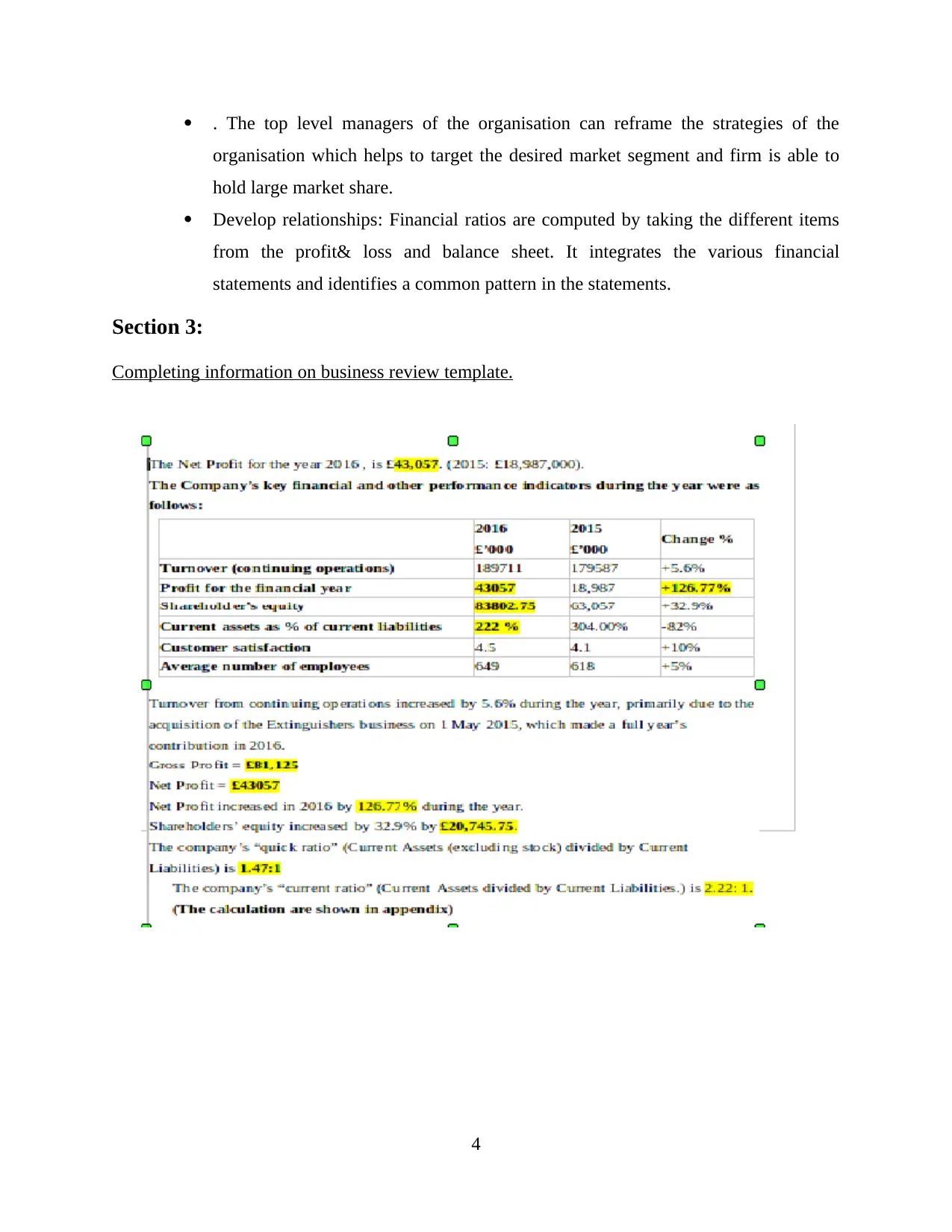
. The top level managers of the organisation can reframe the strategies of the
organisation which helps to target the desired market segment and firm is able to
hold large market share.
Develop relationships: Financial ratios are computed by taking the different items
from the profit& loss and balance sheet. It integrates the various financial
statements and identifies a common pattern in the statements.
Section 3:
Completing information on business review template.
4
organisation which helps to target the desired market segment and firm is able to
hold large market share.
Develop relationships: Financial ratios are computed by taking the different items
from the profit& loss and balance sheet. It integrates the various financial
statements and identifies a common pattern in the statements.
Section 3:
Completing information on business review template.
4
⊘ This is a preview!⊘
Do you want full access?
Subscribe today to unlock all pages.

Trusted by 1+ million students worldwide
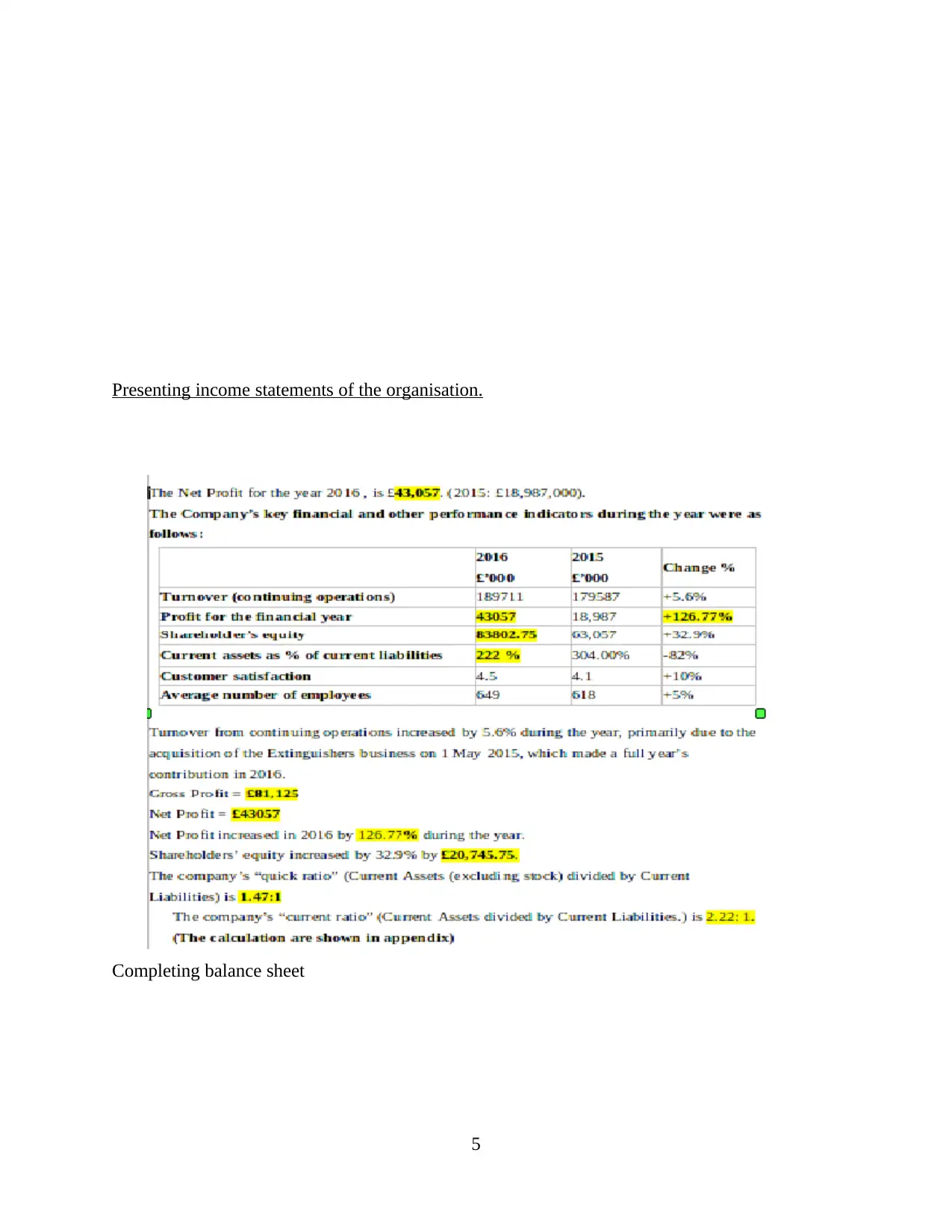
Presenting income statements of the organisation.
Completing balance sheet
5
Completing balance sheet
5
Paraphrase This Document
Need a fresh take? Get an instant paraphrase of this document with our AI Paraphraser
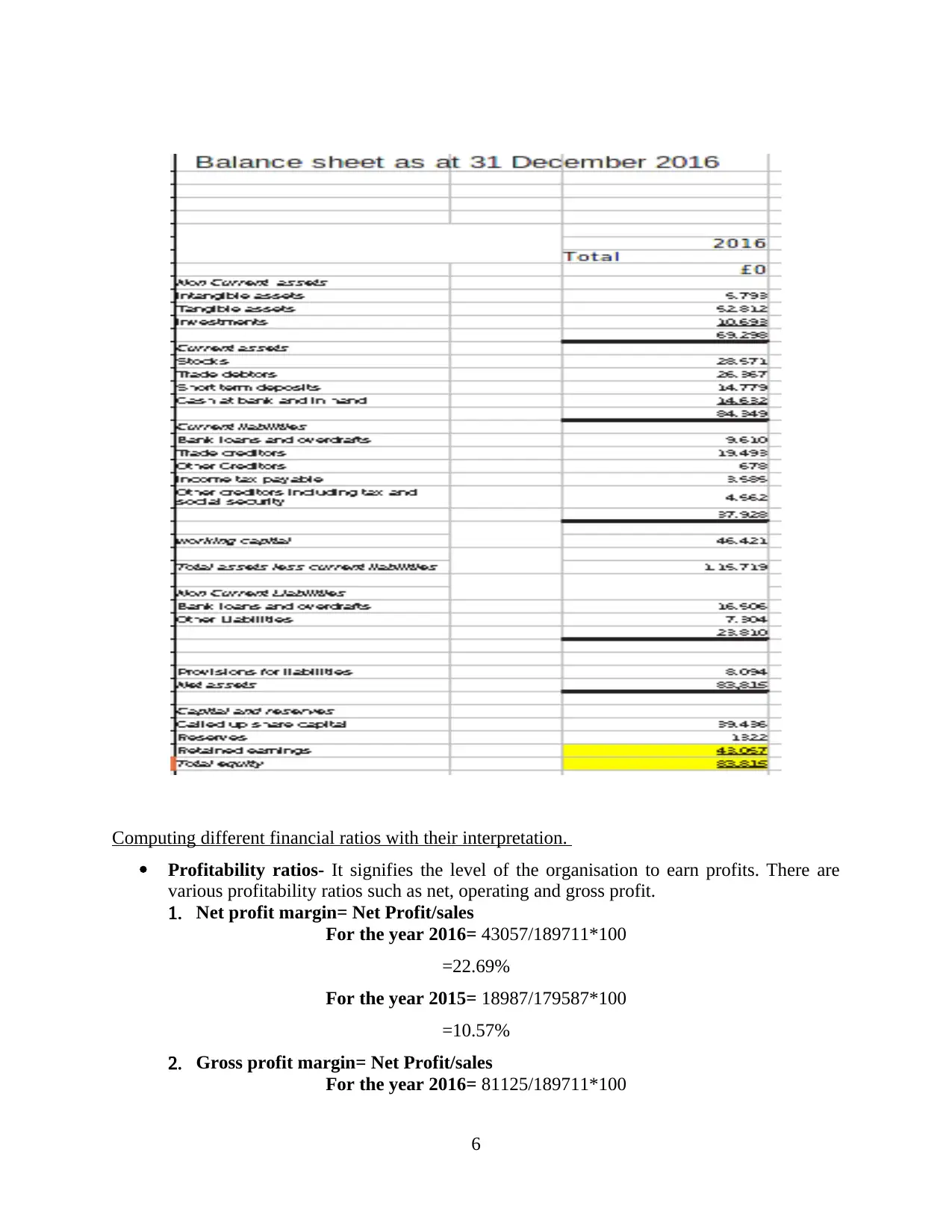
Computing different financial ratios with their interpretation.
Profitability ratios- It signifies the level of the organisation to earn profits. There are
various profitability ratios such as net, operating and gross profit.
1. Net profit margin= Net Profit/sales
For the year 2016= 43057/189711*100
=22.69%
For the year 2015= 18987/179587*100
=10.57%
2. Gross profit margin= Net Profit/sales
For the year 2016= 81125/189711*100
6
Profitability ratios- It signifies the level of the organisation to earn profits. There are
various profitability ratios such as net, operating and gross profit.
1. Net profit margin= Net Profit/sales
For the year 2016= 43057/189711*100
=22.69%
For the year 2015= 18987/179587*100
=10.57%
2. Gross profit margin= Net Profit/sales
For the year 2016= 81125/189711*100
6
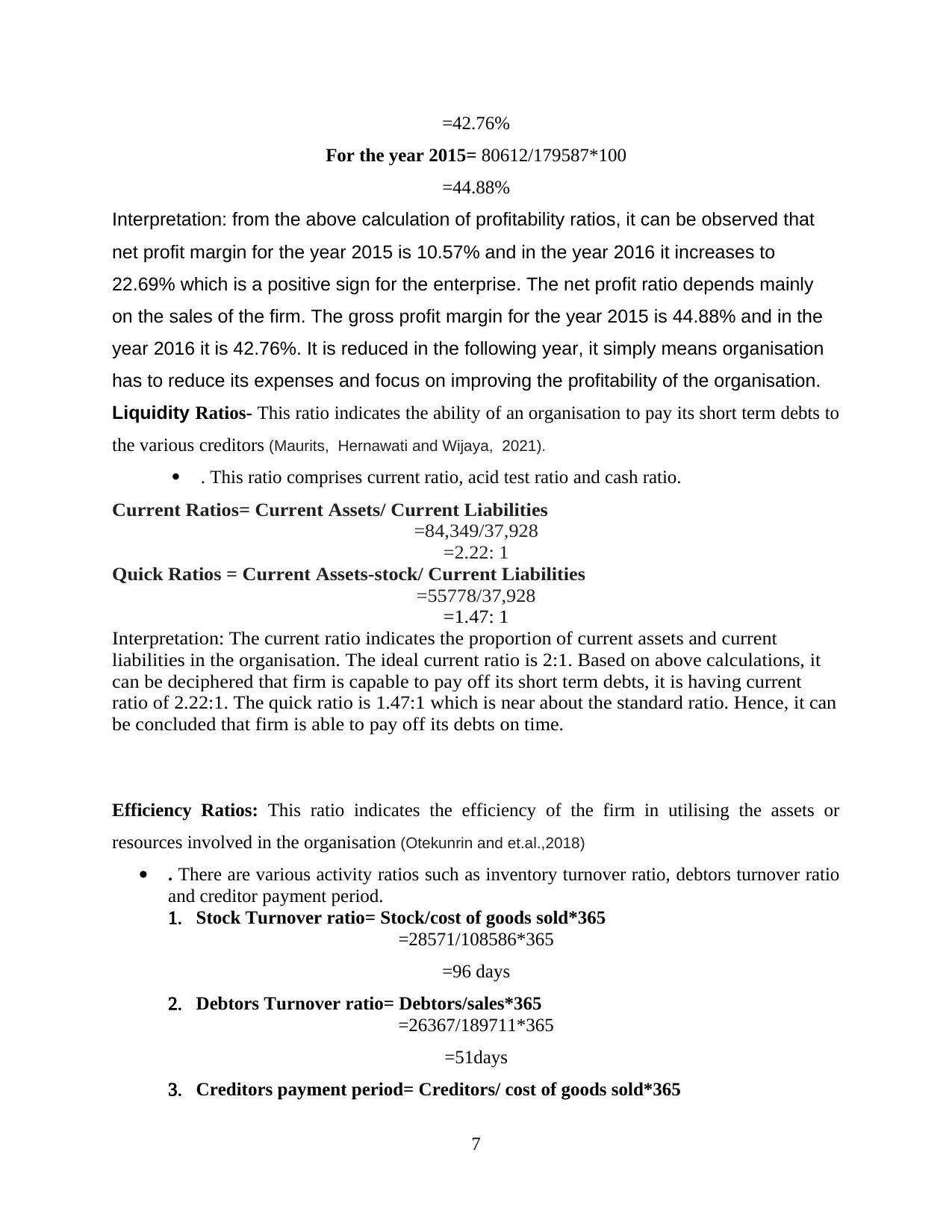
=42.76%
For the year 2015= 80612/179587*100
=44.88%
Interpretation: from the above calculation of profitability ratios, it can be observed that
net profit margin for the year 2015 is 10.57% and in the year 2016 it increases to
22.69% which is a positive sign for the enterprise. The net profit ratio depends mainly
on the sales of the firm. The gross profit margin for the year 2015 is 44.88% and in the
year 2016 it is 42.76%. It is reduced in the following year, it simply means organisation
has to reduce its expenses and focus on improving the profitability of the organisation.
Liquidity Ratios- This ratio indicates the ability of an organisation to pay its short term debts to
the various creditors (Maurits, Hernawati and Wijaya, 2021).
. This ratio comprises current ratio, acid test ratio and cash ratio.
Current Ratios= Current Assets/ Current Liabilities
=84,349/37,928
=2.22: 1
Quick Ratios = Current Assets-stock/ Current Liabilities
=55778/37,928
=1.47: 1
Interpretation: The current ratio indicates the proportion of current assets and current
liabilities in the organisation. The ideal current ratio is 2:1. Based on above calculations, it
can be deciphered that firm is capable to pay off its short term debts, it is having current
ratio of 2.22:1. The quick ratio is 1.47:1 which is near about the standard ratio. Hence, it can
be concluded that firm is able to pay off its debts on time.
Efficiency Ratios: This ratio indicates the efficiency of the firm in utilising the assets or
resources involved in the organisation (Otekunrin and et.al.,2018)
. There are various activity ratios such as inventory turnover ratio, debtors turnover ratio
and creditor payment period.
1. Stock Turnover ratio= Stock/cost of goods sold*365
=28571/108586*365
=96 days
2. Debtors Turnover ratio= Debtors/sales*365
=26367/189711*365
=51days
3. Creditors payment period= Creditors/ cost of goods sold*365
7
For the year 2015= 80612/179587*100
=44.88%
Interpretation: from the above calculation of profitability ratios, it can be observed that
net profit margin for the year 2015 is 10.57% and in the year 2016 it increases to
22.69% which is a positive sign for the enterprise. The net profit ratio depends mainly
on the sales of the firm. The gross profit margin for the year 2015 is 44.88% and in the
year 2016 it is 42.76%. It is reduced in the following year, it simply means organisation
has to reduce its expenses and focus on improving the profitability of the organisation.
Liquidity Ratios- This ratio indicates the ability of an organisation to pay its short term debts to
the various creditors (Maurits, Hernawati and Wijaya, 2021).
. This ratio comprises current ratio, acid test ratio and cash ratio.
Current Ratios= Current Assets/ Current Liabilities
=84,349/37,928
=2.22: 1
Quick Ratios = Current Assets-stock/ Current Liabilities
=55778/37,928
=1.47: 1
Interpretation: The current ratio indicates the proportion of current assets and current
liabilities in the organisation. The ideal current ratio is 2:1. Based on above calculations, it
can be deciphered that firm is capable to pay off its short term debts, it is having current
ratio of 2.22:1. The quick ratio is 1.47:1 which is near about the standard ratio. Hence, it can
be concluded that firm is able to pay off its debts on time.
Efficiency Ratios: This ratio indicates the efficiency of the firm in utilising the assets or
resources involved in the organisation (Otekunrin and et.al.,2018)
. There are various activity ratios such as inventory turnover ratio, debtors turnover ratio
and creditor payment period.
1. Stock Turnover ratio= Stock/cost of goods sold*365
=28571/108586*365
=96 days
2. Debtors Turnover ratio= Debtors/sales*365
=26367/189711*365
=51days
3. Creditors payment period= Creditors/ cost of goods sold*365
7
⊘ This is a preview!⊘
Do you want full access?
Subscribe today to unlock all pages.

Trusted by 1+ million students worldwide
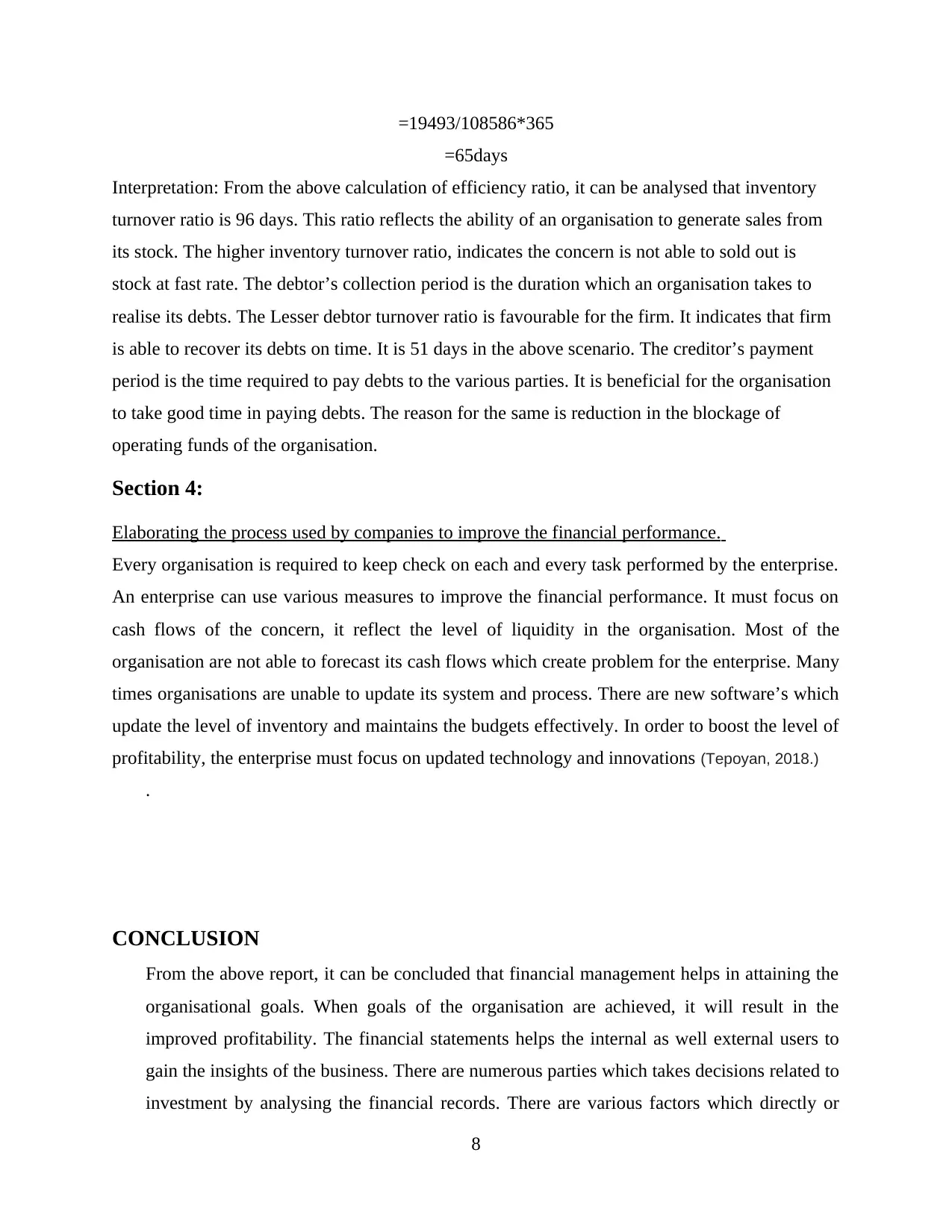
=19493/108586*365
=65days
Interpretation: From the above calculation of efficiency ratio, it can be analysed that inventory
turnover ratio is 96 days. This ratio reflects the ability of an organisation to generate sales from
its stock. The higher inventory turnover ratio, indicates the concern is not able to sold out is
stock at fast rate. The debtor’s collection period is the duration which an organisation takes to
realise its debts. The Lesser debtor turnover ratio is favourable for the firm. It indicates that firm
is able to recover its debts on time. It is 51 days in the above scenario. The creditor’s payment
period is the time required to pay debts to the various parties. It is beneficial for the organisation
to take good time in paying debts. The reason for the same is reduction in the blockage of
operating funds of the organisation.
Section 4:
Elaborating the process used by companies to improve the financial performance.
Every organisation is required to keep check on each and every task performed by the enterprise.
An enterprise can use various measures to improve the financial performance. It must focus on
cash flows of the concern, it reflect the level of liquidity in the organisation. Most of the
organisation are not able to forecast its cash flows which create problem for the enterprise. Many
times organisations are unable to update its system and process. There are new software’s which
update the level of inventory and maintains the budgets effectively. In order to boost the level of
profitability, the enterprise must focus on updated technology and innovations (Tepoyan, 2018.)
.
CONCLUSION
From the above report, it can be concluded that financial management helps in attaining the
organisational goals. When goals of the organisation are achieved, it will result in the
improved profitability. The financial statements helps the internal as well external users to
gain the insights of the business. There are numerous parties which takes decisions related to
investment by analysing the financial records. There are various factors which directly or
8
=65days
Interpretation: From the above calculation of efficiency ratio, it can be analysed that inventory
turnover ratio is 96 days. This ratio reflects the ability of an organisation to generate sales from
its stock. The higher inventory turnover ratio, indicates the concern is not able to sold out is
stock at fast rate. The debtor’s collection period is the duration which an organisation takes to
realise its debts. The Lesser debtor turnover ratio is favourable for the firm. It indicates that firm
is able to recover its debts on time. It is 51 days in the above scenario. The creditor’s payment
period is the time required to pay debts to the various parties. It is beneficial for the organisation
to take good time in paying debts. The reason for the same is reduction in the blockage of
operating funds of the organisation.
Section 4:
Elaborating the process used by companies to improve the financial performance.
Every organisation is required to keep check on each and every task performed by the enterprise.
An enterprise can use various measures to improve the financial performance. It must focus on
cash flows of the concern, it reflect the level of liquidity in the organisation. Most of the
organisation are not able to forecast its cash flows which create problem for the enterprise. Many
times organisations are unable to update its system and process. There are new software’s which
update the level of inventory and maintains the budgets effectively. In order to boost the level of
profitability, the enterprise must focus on updated technology and innovations (Tepoyan, 2018.)
.
CONCLUSION
From the above report, it can be concluded that financial management helps in attaining the
organisational goals. When goals of the organisation are achieved, it will result in the
improved profitability. The financial statements helps the internal as well external users to
gain the insights of the business. There are numerous parties which takes decisions related to
investment by analysing the financial records. There are various factors which directly or
8
Paraphrase This Document
Need a fresh take? Get an instant paraphrase of this document with our AI Paraphraser

indirectly impact the performance of the organisation. An enterprise can use various
measures to improve the financial performance. There are various ratios such as activity
ratios, liquidity ratios, solvency ratios and profitability ratios which helps in comparing the
financial health of the organisation with another competitors. Therefore, financial
management aids in managing the capital of the enterprise.
9
measures to improve the financial performance. There are various ratios such as activity
ratios, liquidity ratios, solvency ratios and profitability ratios which helps in comparing the
financial health of the organisation with another competitors. Therefore, financial
management aids in managing the capital of the enterprise.
9
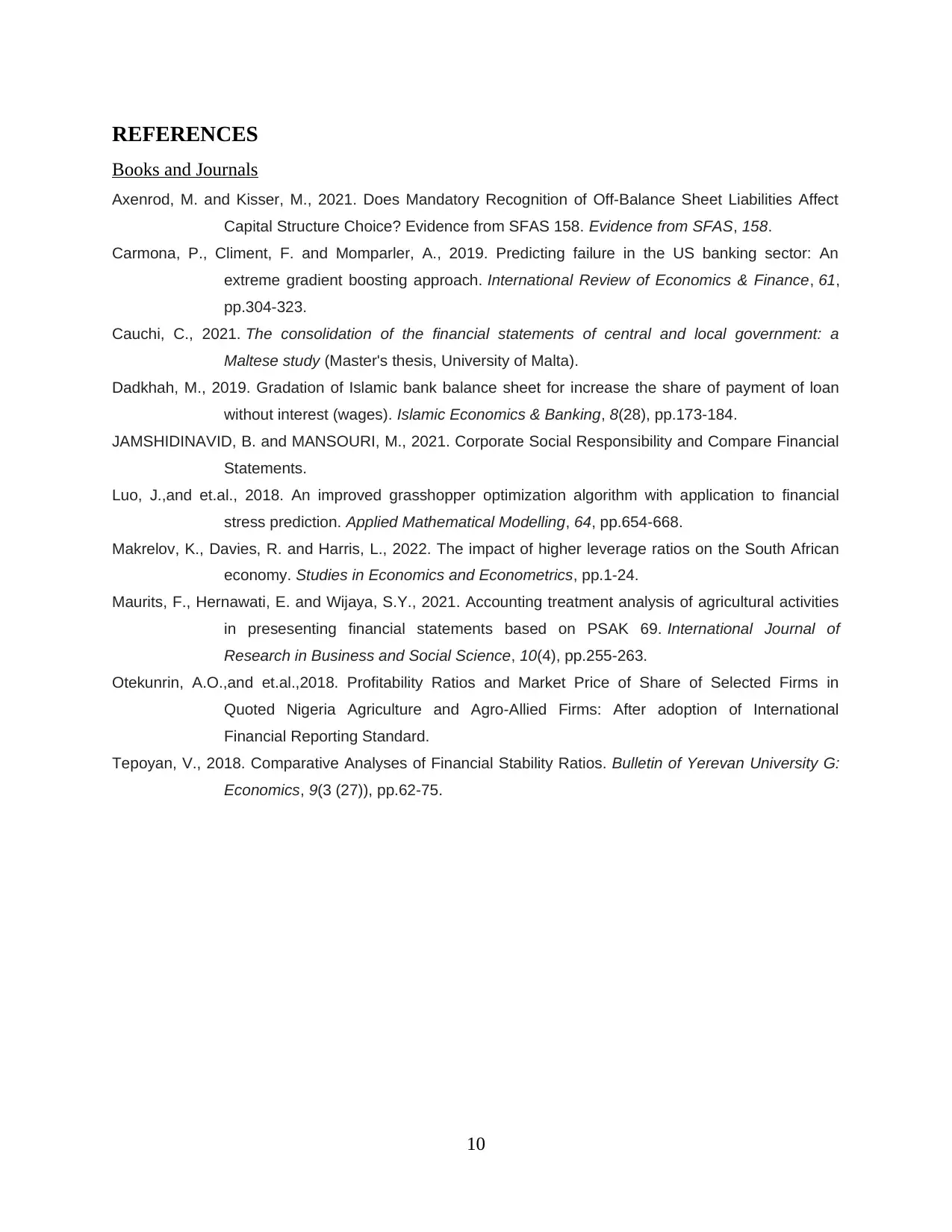
REFERENCES
Books and Journals
Axenrod, M. and Kisser, M., 2021. Does Mandatory Recognition of Off-Balance Sheet Liabilities Affect
Capital Structure Choice? Evidence from SFAS 158. Evidence from SFAS, 158.
Carmona, P., Climent, F. and Momparler, A., 2019. Predicting failure in the US banking sector: An
extreme gradient boosting approach. International Review of Economics & Finance, 61,
pp.304-323.
Cauchi, C., 2021. The consolidation of the financial statements of central and local government: a
Maltese study (Master's thesis, University of Malta).
Dadkhah, M., 2019. Gradation of Islamic bank balance sheet for increase the share of payment of loan
without interest (wages). Islamic Economics & Banking, 8(28), pp.173-184.
JAMSHIDINAVID, B. and MANSOURI, M., 2021. Corporate Social Responsibility and Compare Financial
Statements.
Luo, J.,and et.al., 2018. An improved grasshopper optimization algorithm with application to financial
stress prediction. Applied Mathematical Modelling, 64, pp.654-668.
Makrelov, K., Davies, R. and Harris, L., 2022. The impact of higher leverage ratios on the South African
economy. Studies in Economics and Econometrics, pp.1-24.
Maurits, F., Hernawati, E. and Wijaya, S.Y., 2021. Accounting treatment analysis of agricultural activities
in presesenting financial statements based on PSAK 69. International Journal of
Research in Business and Social Science, 10(4), pp.255-263.
Otekunrin, A.O.,and et.al.,2018. Profitability Ratios and Market Price of Share of Selected Firms in
Quoted Nigeria Agriculture and Agro-Allied Firms: After adoption of International
Financial Reporting Standard.
Tepoyan, V., 2018. Comparative Analyses of Financial Stability Ratios. Bulletin of Yerevan University G:
Economics, 9(3 (27)), pp.62-75.
10
Books and Journals
Axenrod, M. and Kisser, M., 2021. Does Mandatory Recognition of Off-Balance Sheet Liabilities Affect
Capital Structure Choice? Evidence from SFAS 158. Evidence from SFAS, 158.
Carmona, P., Climent, F. and Momparler, A., 2019. Predicting failure in the US banking sector: An
extreme gradient boosting approach. International Review of Economics & Finance, 61,
pp.304-323.
Cauchi, C., 2021. The consolidation of the financial statements of central and local government: a
Maltese study (Master's thesis, University of Malta).
Dadkhah, M., 2019. Gradation of Islamic bank balance sheet for increase the share of payment of loan
without interest (wages). Islamic Economics & Banking, 8(28), pp.173-184.
JAMSHIDINAVID, B. and MANSOURI, M., 2021. Corporate Social Responsibility and Compare Financial
Statements.
Luo, J.,and et.al., 2018. An improved grasshopper optimization algorithm with application to financial
stress prediction. Applied Mathematical Modelling, 64, pp.654-668.
Makrelov, K., Davies, R. and Harris, L., 2022. The impact of higher leverage ratios on the South African
economy. Studies in Economics and Econometrics, pp.1-24.
Maurits, F., Hernawati, E. and Wijaya, S.Y., 2021. Accounting treatment analysis of agricultural activities
in presesenting financial statements based on PSAK 69. International Journal of
Research in Business and Social Science, 10(4), pp.255-263.
Otekunrin, A.O.,and et.al.,2018. Profitability Ratios and Market Price of Share of Selected Firms in
Quoted Nigeria Agriculture and Agro-Allied Firms: After adoption of International
Financial Reporting Standard.
Tepoyan, V., 2018. Comparative Analyses of Financial Stability Ratios. Bulletin of Yerevan University G:
Economics, 9(3 (27)), pp.62-75.
10
⊘ This is a preview!⊘
Do you want full access?
Subscribe today to unlock all pages.

Trusted by 1+ million students worldwide
1 out of 12
Related Documents
Your All-in-One AI-Powered Toolkit for Academic Success.
+13062052269
info@desklib.com
Available 24*7 on WhatsApp / Email
![[object Object]](/_next/static/media/star-bottom.7253800d.svg)
Unlock your academic potential
Copyright © 2020–2025 A2Z Services. All Rights Reserved. Developed and managed by ZUCOL.


